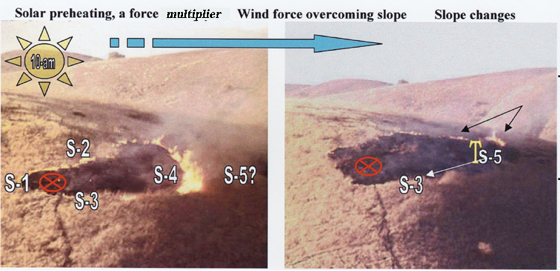Ground Truth
Many complex factors influence the ignition, rate of spread, and general behavior of fires. Some of these factors can be measured more or less precisely with instruments. Others do not lend themselves to exact measurements and therefore must be evaluated in general terms. The combined effects of all factors, whether measured precisely or not, determine the behavior of a fire. No single factor, such as wind, steepness of slope, or kind of fuel, will provide the answer to questions of when and where fires will start and how fast they will spread.
J.S. Barrows
You will remember that there are three primary forces causing variations in fire behavior. They are wind, slope, and pre-heat. Each side of a fire, the head, flanks and heel, has a different alignment and intensity. For example, if the head is in alignment with the wind, then the flanks and heel will be out of alignment. Each of these alignment sets produces a fire signature, which is the observed fire behavior within the current alignment of forces. The fire signature is the ground truth. The fire is telling you how it will behave in similar alignments and conditions
Learn from the past, predict the future
In order to predict fire behavior, you first have to understand how to read wildland fire.
Observations of the variation in fire behavior are made as the fire is burning over terrain, These variations are then explained as to the cause. The causes of these variables are then recognized and the terrain or weather factors are matched to the causes. If the causes remain valid for the short-term future then the areas in the exposure fuels are segregated into two targets. One area will be where fire suppression can be successful and the other will be designated an area where fire behavior is uncontrollable. These areas are highlighted on a map display. The fire will produce a variation of signature behavior that can be predicted to reoccur as the fire burns over the terrain. This signature behavior will replicate when the alignment of forces causing the behavior reoccurs. Identification of these areas in front of the flaming front can be determined and displayed for others to view and consider the implications.
Replication
The terrain will host replications of these fire signatures on those exposures that have a similar alignment. Where and when the alignment of forces in the path of the fire is similar to those of a previous fire signature, the fire behavior will be similar. When we identify how these forces are aligned ahead of the fire, and have paid attention to previous fire signatures, then we can more accurately predict the fire signature that will result.
What is important for situational awareness is when and where the fire signature will exceed the threshold of safety for the firefighter. This awareness becomes more accurate with practice.
Trigger Points
A trigger point is a place on the terrain where a change in the alignment of forces will change the fire behavior, creating either opportunity or danger. Trigger points are a time and/or place where the tactic or placement of resources needs to be changed to assure firefighter safety. There are two crucial trigger points to establish:
- One is where the fire will change;
- The other is when and where fire on the landscape triggers a decision to change tactics.
Selecting a trigger point of change or the trigger point for tactical adjustment requires firsthand experience. Neither trigger point was established when the 1985 Butte Fire made an in-alignment run and drove firefighters into fire shelters. (12)
Case Study — The Footprint Test Burn
In these photos, there are sunlit and shaded fuels and a 3 mph wind blowing from left to right; the head fire in the left hand photo has 10’ flame lengths. Wind, slope and preheat are acting on the fire to either help or hinder the spread. The alignment of these forces make the fire burn with more intensity and when the forces are out of alignment the fire behavior ebbs. Observe how the fire signatures change as the alignment of forces change. Examine these snapshots and ask yourself the following questions:
- What is making the fire burn with different intensities?
- What is the cause of the variations seen in these two pictures?
- What is the fire telling us?
The fire signature at the heel (S-1), upper left-hand flank (S-2), the lower right-hand flank (S-3) will not change alignments with the forces of wind, slope and preheat. Therefore the fire will continue to advance with the same intensity and rate of spread on these fronts. However, the fire signature at S-5 will change because the force alignments change between S-4 and S-5:
- The fire moves out of alignment with slope and into cool fuel.
- The S-5 signature will replicate the fire signature of S-3, as can be seen in the right hand photo.
Summary
Fire signatures are derived from the fire intensity and rate of spread due to the various alignments of wind, slope and solar preheating. These signatures are captured for use in predicting fire behavior in the path of the fire.
The observed fire behavior is the ground truth. What does this mean? It means the fire is expressing exactly how it will behave in the current conditions. It’s a fact. It’s the truth.
Copyright © 2016 by Doug Campbell.
